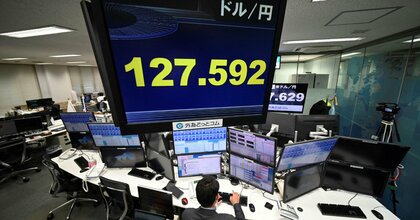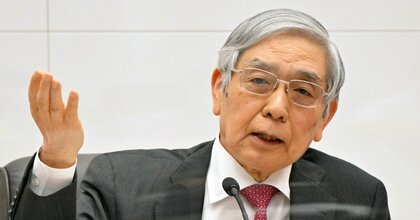Originally published in Japanese on Feb. 14, 2023
Importance of the 2% inflation target
With regards to the 2% inflation target, Ueda supports the target in order to avoid the “effective lower bound” and thus to create sufficient room for lowering the (short-term) policy rate during an economic downturn. He points out the possibility that Japan's medium- to long-term growth rate has been pushed down over the past 25 years as the effective lower bound prevailed. In other words, maintaining the 2% inflation target and working to achieve it is essential to raising Japan’s economic growth rate. Other central banks in Europe and the United States also set 2% inflation targets for the same reason: to avoid the effective lower bound.
At the same time, Ueda believes that even if the inflation rate exceeds 2%, Japan’s current underlying inflation is not in a position to stably stay there. This assessment is based on three factors: the low level of a globally-adopted core inflation indicator (the rate of inflation excluding energy and all food, rather than excluding energy and just fresh food); many economists’ projection that current inflation will fall below 2% in the second half of this year and thus the current high inflation is unsustainable; and a global economic slowdown this year that might cause headwinds for Japan’s economy through weaker foreign demand.
For these reasons, he dismissed the view spreading last year that the BOJ should perform interest rate hikes to prevent an excessive depreciation of the yen. He stressed that such interest rate hikes would further hinder the realization of the 2% inflation target and invite recession. Premature rate hikes will not last long, as demonstrated in 2000 when the zero-interest rate policy was abandoned and in 2016 when quantitative easing was removed. Rather, policy coordination by combining the current monetary easing with the government's fiscal measures targeting low-income earners is more desirable.
I have previously expressed the same view about weak current underlying inflation. As of December 2022, the globally-adopted core inflation indicator is 1.6% in Japan. Of this, the service inflation rate, which accounts for a large proportion of the core inflation rate, is just 0.8%. This means the current 4% (headline) inflation is solely due to energy and food inflation or supply-side factors. As the supply-side factors weaken and once companies complete a gradual pass-through of increased production costs to retail prices, inflation will likely drop again. This is why many economists view that inflation will drop below 2% toward the end of this year.
In the United States, meanwhile, the core inflation rate is currently 4.4% (the services inflation rate is 5.2%) based on personal consumption expenditure prices. In the Eurozone, it is 5.2% (services inflation rate is 4.4%). All of these inflation indicators are well above their 2% inflation target. That is why these central banks, whose monetary policy mandates lie on price stability, had no choice but to raise policy interest rates.
As there is no prospect of stable inflation of 2% in Japan for the time being and underlying inflation remains low, Ueda is presumably of the position that the current monetary easing should be continued.
Forward guidance and tweaks to YCC
On the second issue, there are two types of forward guidance provided by the BOJ. The first is the declaration that the central bank will continue with Quantitative and Qualitative Monetary Easing (QQE) with YCC, aiming to achieve the 2% inflation target, as long as it is necessary to maintain the target in a stable manner. Since April 2013 when QQE was adopted, the BOJ has continued to use similar expressions.
The other is the forward guidance—the so-called “overshooting commitment”—introduced in 2016 when the Bank switched from QQE (which targets the annual net purchase amount of JGBs and other assets) to YCC (which applies a negative 0.1% interest rate on the part of excess reserves and maintains 10-year JGB yields at around 0%). The guidance states that the BOJ will continue expanding the monetary base until inflation excluding fresh food exceeds 2% and stays there in a stable manner.
Ueda referred to the first forward guidance and pointed out that this declaration has been effectively generating monetary easing effects. For this reason, this forward guidance will likely be maintained in order to achieve the 2% target under the new governorship.
Interestingly, moreover, he touched upon the relationship between this forward guidance and tweaks to YCC. He is opposed to the use of tweaks to YCC including an expansion of the 10-year target range and a shortening of the target maturity from the 10-year to the 5- or 7-year. This is because such tweaks are inconsistent with the aforementioned first piece of forward guidance. Given that the goal of achieving 2% inflation stably is not in sight, such premature tweaks may end up forcing the BOJ to change course once again toward easing later.
Such action may undermine not only the BOJ’s credibility, but also invite a massive speculative bond sell-off, he emphasized. Since he wrote the article, the BOJ implemented the expansion of the target range from 0.25% to 0.5% last December. Thus, it is interesting to know how he views now about the decision with which he does not agree.
Indeed, investors sold a large amount of JGBs at the time of the BOJ's monetary policy meeting in December last year, when it suddenly widened the 10-year target range to 0.5%, and at the meeting in January of this year, when the market was wary that the target range might rise again by surprise. Thus, the BOJ was forced to purchase a large amount of 10-year bonds.
As long as there is no prospect that Japan's inflation trend will stably reach 2% in the near future, it is likely that the BOJ will continue YCC through large-scale purchases of government bonds and long-term fund-supplying operations (open market operations), which will be described later. In that case, the focus will be on how the BOJ will deal with the side effects arising from continued large-scale purchases of government bonds, such as distortions in the bond market and the deterioration of the bond market function.
Recent BOJ moves
Here, I will briefly explain the recent BOJ actions. The BOJ highlighted two reasons for expanding the target range last December—namely, correcting the "distortions" and "declining functioning" of the bond market.
Distortions refer to the state in which the 10-year yield, which the BOJ had (at the time) kept below 0.25%, fell below the yields of JGBs with remaining maturities of shorter than 10 years (i.e., 8 or 9 years). Amid growing global upward pressures on interest rates, the BOJ decided to maintain the target range by carrying out fixed-rate JGB purchase operations (buying unlimited 10-year JGBs at a 0.25% interest rate) every business day from April last year. This put a lot of downward pressure on primarily the 10-year yield, causing distortions.
Meanwhile, the degree of functioning in the bond market has substantially deteriorated with the continuous use of fixed-rate purchase operations. The BOJ's market intervention is disproportionately large, so the number of buyers and sellers in the JGB market has shrunk. As a result, most transactions in the bond market concentrate on sales of JGBs by market participants to the BOJ as the largest investor. When the number of market participants decreases and the depth of the market thins, yields tend to fluctuate greatly when a sudden event occurs.
In addition, since government bond yields are also the basis for interest rates on corporate bonds and bank loans, market participants are becoming increasingly concerned that distortions and the deterioration in the functioning of government bonds will adversely affect the pricing and procurement of private-sector funds.
Reflecting on these concerns, the BOJ attempted to correct these problems by expanding the 10-year target range, but the distortions had not been corrected. For this reason, at the meeting held in January this year, the BOJ decided to revise the variable rate method of fund-supplying operations (open market operations) by lengthening the period from one year up to 10 years. These operations are to provide loans to banks against eligible collateral, including JGBs. Globally, central banks use such open market operations mainly to supply short-term funds for several months. The BOJ’s action is viewed as an unusual response.
Immediately, on January 23, the five-year fund-supplying operation was implemented. The average successful bid interest rate was 0.145%. In other words, if banks borrow at a low-interest rate of just over 0.1% and purchase 5- to 10-year government bonds, they will definitely get a profit margin. Thus, the number of bids was substantially high at 3.1 times the offer. Since then, the distortion has been somewhat corrected, but not completely eliminated.
Looking for an exit
As for the third issue, Ueda argued that an exit strategy should be in place, and that the current monetary easing framework should also be seriously reconsidered at some point in the future.
In addition, as an exit policy, he referred to the case of the Reserve Bank of Australia (Australia's central bank), which had introduced 3-year yield control in 2020 and abolished it as a one-off adjustment in 2021. This one-off adjustment is preferred to the tweaks to YCC mentioned above, he said.
The Reserve Bank of Australia set the 3-year government bond rate at 0.25% in March 2020, the same as the (short-term) policy rate, and this yield target was to be maintained until progress toward full employment was achieved and there was confidence that inflation would stably reach the target range of 2-3%. The central bank attempted to maintain the target rates by purchasing government bonds. Both rates were cut to 0.1% in November of the same year.
As the economy recovered more than expected, in July 2021 the Reserve Bank of Australia decided to apply a 0.1% interest rate target to the specific shorter April 2024 government bond issue—three months shorter than 3-year bonds. In other words, by targeting an interest rate on a specific bond issue with a term shorter than three years, the maturity of the specific issue automatically shortens as time goes by and can end when the principal is redeemed in less than 3 years.
This decision shifts from a fixed 3-year remaining period for interest rate targets to a system that automatically shortens the remaining period over time. After that, in November 2021, the central bank stopped the yield target completely as inflation achieved its target range. To be precise, this was not a one-off adjustment as suggested by Ueda. It was a two-step approach of first automatically shortening the target remaining term and then suspending it without waiting for maturity.
According to the central bank, the average 3-year bond yields since the introduction of the yield control was almost the same as the target interest rate. However, there were cases where yields were above the target for a time.
Even in Australia, since early 2021, when upward pressure on long-term interest yields intensified, the central bank struggled to maintain the 3-year yield control. In March of the same year, the bank considered abolishing the interest rate control entirely, but decided to continue because employment and the inflation rate had not yet improved at that time. Once the goal was achieved, the decision was made to abolish it.
What is the long-term strategy that Ueda has in mind, and when will it be considered? Long-term yield control in Japan targets the 10-year yield, rather than the 3-year yield chosen by Australia. If the BOJ follows the Australian approach, the 0.5% yield will be maintained while the target maturity of the JGB issue could be shorter than the 10-year. Still, this automatic shortening approach will take nearly 10 years. During this time, the BOJ may be exposed to speculative selling attacks on JGBs. If the BOJ decides to stop the approach midway, it needs to provide some convincing grounds.
If the YCC were to be abolished at once instead of adopting the Australian automatic shortening approach, long-term yields could easily surge (although such a surge may be temporary). It may be necessary to utilize large amounts of long-term funds-supplying operations frequently in order to mitigate yield spikes.
I agree that having an exit strategy is important. At the same time, once the BOJ explains its exit strategy, financial institutions and investors may begin to prepare for it and sell JGBs to avoid potential losses. Upward pressure on long-term yields will hence rise, and there is a risk that it may become even more challenging to continue YCC.
Final Remarks
Finally, what decision will the BOJ make if there remains no prospect of stable 2% inflation in Japan over the next five years? Will the BOJ decide to make the 2% price stability target more flexible (for example, change it to an inflation target range of 1-3%)? Will it maintain the 2% inflation target and continue with the current monetary easing despite the growing side effects? Or alternatively, will it pursue an exit strategy? This will likely be a very important decision as it will affect the credibility of the central bank.
Meanwhile, it should be noted that the inflation structure may be changing. Due to factors such as the continuation of COVID-19 and variant viruses, the aging population, climate change, and the diversification of production locations because of geopolitical risks, the world and Japan may become more prone to inflation than before. Japanese companies are also more willing to raise wages than ever before. If many companies shift to the idea of raising wages every year as a matter of course in order to increase workers’ motivation, and improve productivity and increase earning power to realize this, achieving 2% inflation stably may be possible.
Sayuri Shirai is a professor of the Faculty of Policy Management, Keio University and former Bank of Japan board member (2011-2016). She holds Ph.D. in economics from Columbia University. The views expressed here are her own.











